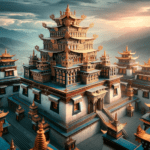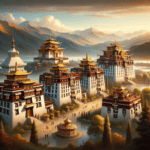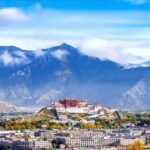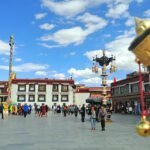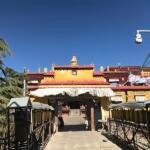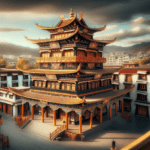The Enchanting History of Ani Tsamkhong Nunnery
Nestled southeast of Jokhang Temple in the heart of Lhasa, Ani Tsamkhong Nunnery stands as a beacon of spiritual history. The nunnery, originally known as Tsamkhong, meaning “practice cave,” is famed for its association with the Tibetan king, Songtsen Gampo. This sacred site dates back to the 15th century, when legend has it that Songtsen Gampo meditated in a cave here to prevent the flooding of the Lhasa River and protect the Jokhang Temple.
Architectural Marvels of Ani Tsamkhong Nunnery
This 12-story high nunnery captivates visitors with its square-shaped structure, central Sutra Hall, and the meditation cave of Songtsen Gampo on the first floor. The Sutra Hall, facing south and accessible via two stone steps, is a highlight for pilgrims and visitors alike.
A Center for Peace and Devotion: Ani Tsamkhong Nunnery, enriched with Tibetan Buddhist culture, offers a tranquil retreat for spiritual seekers. The site includes several prayer wheels and a large mulberry-burning furnace in the south, enhancing the ambience of devotion and peace.
Tsamkhong: The Legacy of Songtsen Gampo‘s Meditation
At the heart of Ani Tsamkhong Nunnery is the revered meditation cave of Songtsen Gampo. Positioned facing west and east, this cave is not just a historical landmark but a symbol of the nunnery’s deep-rooted spiritual significance.
For those exploring Tibetan culture and spirituality, a visit to Ani Tsamkhong Nunnery is a must. Experience the serenity, soak in the rich history, and witness the unique architectural beauty of this sacred Lhasa landmark.
Check the Ani Tsamkhung Tripadvisor Reviews
Exploring the Rich Traditions of Ani Tsamkhong Nunnery
Architectural Layout and Artistry of Ani Tsamkhong Nunnery
To the east of the Great Sutra Hall of Ani Tsamkhong Nunnery, located one meter away, stand two-story buildings. On the first floor, the sutra hall houses several Buddha statues, while the second-floor small sutra hall is home to the statues of Tsongkhapa and Nagarjuna Bodhisattva (the founder of the Madhyamaka school), with thangkas adorning the north wall. The nunnery, encircled by dormitories for the nuns, is designed around the main sutra hall and spans a height of 2 to 3 stories.
Vibrant Religious Rituals at Ani Tsamkhong Nunnery
Ani Tsamkhong Nunnery observes seven fixed religious rituals per month. These rituals include the Yogini ritual on the 8th, Tara and Medicine Buddha rituals on the 10th, Chakrasamvara Guru offering on the 15th, the Sixteen Arhat Ritual, Her Majesty Buddha worship on the 21st, Yamantaka Ritual on the 25th, and the Dharma protector ritual on the 30th. Each ritual typically begins at 8:30 in the morning and concludes by 6 in the evening.
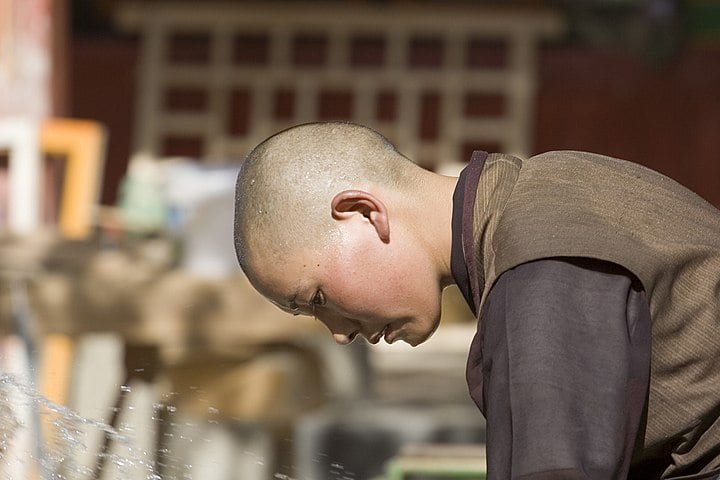
Solemn Ritual Procedures of the Nuns
The rituals at Ani Tsamkhong Nunnery commence with the nuns gathering outside the sutra hall in the morning. They enter the hall barefoot after removing their shoes, showing reverence by bowing and performing three long kowtows to the Buddha and Bodhisattva statues. Seated in an orderly fashion, they are led by the instructor and the sutra master (dbu-mdzad), with the incense lamp master coordinating with other nuns. The ceremony includes reciting the Tara Sutra, offering highland barley wine to the Dharma Protector, and chanting the Heart Sutra, the White Umbrella-Covered Buddha Mother Sutra, and the Lion-Faced Mother Buddha Sutra, lending a profound solemnity to the rituals.
The Unique Blend of Monastic and Secular Life in Ani Tsamkhong Nunnery
Ani Tsamkhong Nunnery, part of the Gelug Sect, has a rich history of hosting nuns from noble and merchant families, leading to a blend of monastic and secular lifestyles. This unique aspect of the nunnery has been the subject of various local songs and stories in Lhasa. The nunnery has also been a topic in literature, notably in “Wise Eyes Shining on the Snowy Land” by Wangjiu Dorje, which provides insights into the life in Lhasa and the nunnery through the story of his mother, a former nun of Ani Tsamkhong.
Ani Tsamkhong Nunnery stands as a testament to the intricate blend of religious devotion and cultural richness, offering a unique glimpse into the spiritual and social dynamics of Tibetan Buddhism.
Ani Tsamkhong Nunnery: A Treasure Trove of Spiritual Art and History
① Statues: A Blend of Divinity and Reverence
The sutra hall of Ani Tsamkhong Nunnery doubles as a Buddhist hall, featuring statues categorized into four distinct groups:
- Buddha Statues: This category includes Sakyamuni Buddha, Immovable Tathagata, Sakyamuni Nengren, and the Eleven-faced Avalokitesvara, each radiating serene beauty. The Eleven-faced Avalokitesvara, being the largest, is the temple’s main Buddha.
- Eminent Monks and Great Virtues: This group features figures like Padmasambhava and his concubine Mandarewa Dakini Yeshe Tsoje, Tsongkhapa and Jia Caojie Zhujie, Guijue Dongden, Pabengka Living Buddha, Trijang Rinpoche, and Ling Rinpo, with the last one being unique to this temple.
- Protector Deity (chos-skyong): Palden Lhamo, the primary deity of worship, is the sole protector deity offered by this temple, with three offerings placed in front of the altar.
- Deity (yi-dam): Deities like Chakrasamvara, Yogini, Green Tara, and White Tara fall under this category. These statues also represent the wrathful aspect, essential for every Tibetan Tantra practitioner.
② Murals: Captivating Artwork and Symbolism
The murals of Ani Tsamkhong Nunnery are a sight to behold:
- The west wall of the outer sutra hall features a painting of King Horsehead Ming.
- The east wall displays a series of ferocious and intimidating depictions.
- Around the skylight, the most notable murals include groups of three North Honored Ones, Tsongkhapa and his disciples, Green Tara and Yoga Mother on the east wall, and twin statues of the four-armed Avalokitesvara and Chakrasamvara on the west wall, all beautifully rendered.
③ Thangkas: Preserving Ancient Spiritual Art
Ani Tsamkhong Nunnery houses an impressive collection of old thangkas:
- The right side of the three Lotus and Peanuts statues on the east wall of the sutra hall features Kalachakra and White Umbrella-cover thangkas.
- Mighty deity thangkas hang from the pillars of the sutra hall.
- A large Guru Futian thangka, measuring 203 meters high, adorns the sutra hall’s throne, with Tsongkhapa prominently in the center as the Dharma seal.
④ Songtsen Gampo’s Practice Cave: A Sacred Relic
Located in the north of the lower floor of the Sutra Hall, Songtsen Gampo’s Practice Cave is a major cultural relic of the temple. A new statue of Songtsen Gampo was erected atop the cave during the 1984 renovation. This historically recorded original site holds a highly venerated black stone at the cave’s bottom.
Ani Tsamkhong Nunnery, with its rich collection of statues, murals, thangkas, and the sacred practice cave, stands as a testament to the profound spiritual and cultural heritage of Tibetan Buddhism.
Tour Tips: Experience the Charm of Ani Tsamkhong Nunnery’s Sweet Teahouse
Discover the Unique Ani Tsamkhong Nunnery Sweet Teahouse
In the courtyard of Ani Tsamkhong Nunnery, you’ll find the renowned Sweet Teahouse, a delightful open-air greenhouse. This teahouse, known for its simplicity and unpretentious ambience, offers a glimpse into everyday Tibetan life.
A Morning Retreat for Tibetan Locals
Each morning, after completing their prayer rituals at Barkhor Street, Tibetan locals often retreat to the Sweet Teahouse for relaxation and refreshment. This teahouse, primarily served by nuns, becomes a bustling hub of community and tranquillity.
Savour the Rich Flavors of Tibetan Sweet Tea
The Sweet Tea at Ani Tsamkhong Nunnery is famed for its rich, full-bodied taste, and it’s surprisingly affordable. It’s a perfect way to recharge, especially after a long day of shopping or exploring. Pair a pot of sweet tea with a bowl of traditional Tibetan noodles and two beef buns for a fulfilling meal.
Additional Amenities: Clinics and Shops
Conveniently located next to the teahouse are clinics and shops, adding to the comfort and convenience for visitors. You can enjoy a hearty meal, browse local products, or seek medical attention if needed, all within the serene environment of the nunnery. Visiting the Ani Tsamkhong Nunnery Sweet Teahouse offers not just a taste of delicious Tibetan cuisine but also a chance to immerse yourself in the local culture and daily life of Lhasa.

